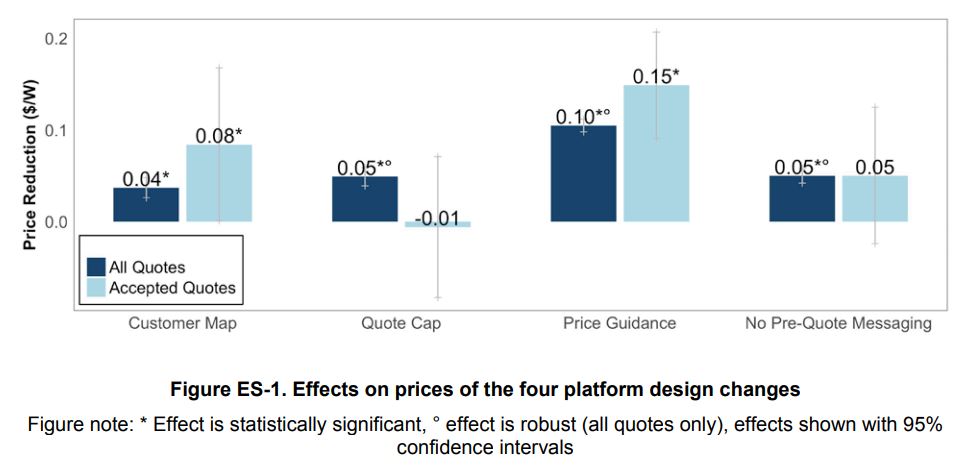Who knows best? Is it the customer, the installer, or the data that sits somewhere between the perceptions of the two? And if we are to entrust the data, how do we watch the data makers?
EnergySage has become a significant conduit for residential solar power traffic. Back in 2012, the team won a $500,000 grant to build a website, “streamlining the solar photovoltaic purchase process for installers while creating a novel reverse auction platform to ensure consumers receive the best prices available while lowering sales costs for installers.”
New research, Effects of Platform Design on the Customer Experience in an Online Solar PV Marketplace, (.pdf download) suggests that certain aspects of the website do in fact lower pricing – but not necessarily the one giving customers a broader choice of proposals to choose from.

The feature with the greatest measured effect – installer focused price guidance – is seemingly one with quite a bit to unpack:
The “Price Guidance” change had the strongest impact, reducing quote prices by $0.10/W and purchase prices by $0.15/W, on average and holding all other factors constant.
Since March 2017 when the Price Guidance feature was put in place, installers in the EnergySage online marketplace were provided information about competitive prices in the customer’s area before submitting a quote. The guidance is based on price data from EnergySage quotes made in the customer’s area during the previous six months. The researchers noted:
The price guidance could act as an anchor (Tversky and Kahneman 1974), inducing installers to offer quotes close to the price guidance point. Galinsky and Mussweiler (2001) study anchoring in negotiations between buyer and seller, finding that first offer prices (the anchor) are strong predictors of final settlement prices.
EnergySage now has to recognize that they are now more than just a reflection of the market, but a market maker.
In communications with pv magazine, EnergySage noted that none of the four marketplace design changes studied were actually intended to lower prices, but were instead aimed toward improving customer experience. And it was the critical finding by NREL, that they did improve customer experience, that EnergySage hopes to show off:
The customer map increased the conversion of website visitors into customers, the quote cap shortened waiting times for customers to receive quotes, and the price guidance feature reduced quote price dispersion. This latter effect is particularly encouraging, because price dispersion may erode customer confidence in PV adoption.”
The two other tools that also showed significance in pricing was limiting the number of quotes to seven, and offering buyers a local customer map and the quotes that they received from local installers. One design change whose effect were unclear was the new policy of no “pre-quote messaging”.

Also noted was that the average customer was willing to pay – based on purchase data, not polling data – 64¢/W greater for premium solar panels, while solar installers were assuming that they’d only pay 54¢/W. This research aligns with significant data suggesting aesthetics and efficiency are the number one and two choice for a customer – and gives credence to the Tesla Solar Roof being a highly desired solar product, even if it is expensive.
The goal of the research was to prove that not only does having a platform matter, but that very specific aspects of the design of those platforms were the true drivers of change. In this research we see that customers want to know the good to honest, fair price first, and are then ready to start the upgrades from there.
This content is protected by copyright and may not be reused. If you want to cooperate with us and would like to reuse some of our content, please contact: editors@pv-magazine.com.








I have had two quotes from solar installers – both from people walking the neighborhood. Both were in the $4.50/W price area and both used 250W panels. I have limited good roof space and so would prefer premium panels. I also know that if someone can use 330W+ panels they can go from 20 panels down to 15 panels for a 5kW system – so save on space, racking/wiring/inverter/install costs.
Also, neither company really wanted to talk about the panels I had to do the math to figure out what size panel they were using.
At this point I will probably be replacing the roof at the same time or before getting solar so will probably wait.
Hi John, If you are planing to replacing your roof and install Solar Panel, the solution is replacing your roof to Hanergy’s HanTile.